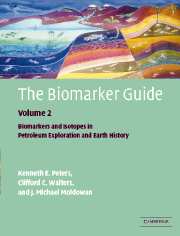Book contents
- Frontmatter
- Contents
- About the authors
- Preface
- Purpose
- Acknowledgments
- PART II BIOMARKERS AND ISOTOPES IN PETROLEUM SYSTEMS AND EARTH HISTORY
- 12 Geochemical correlation and chemometrics
- 13 Source- and age-related biomarker parameters
- 14 Maturity-related biomarker parameters
- 15 Non-biomarker maturity parameters
- 16 Biodegradation parameters
- 17 Tectonic and biotic history of the Earth
- 18 Petroleum systems through time
- 19 Problem areas and further work
- Appendix: geologic time charts
- Glossary
- References
- Index
15 - Non-biomarker maturity parameters
Published online by Cambridge University Press: 05 April 2013
- Frontmatter
- Contents
- About the authors
- Preface
- Purpose
- Acknowledgments
- PART II BIOMARKERS AND ISOTOPES IN PETROLEUM SYSTEMS AND EARTH HISTORY
- 12 Geochemical correlation and chemometrics
- 13 Source- and age-related biomarker parameters
- 14 Maturity-related biomarker parameters
- 15 Non-biomarker maturity parameters
- 16 Biodegradation parameters
- 17 Tectonic and biotic history of the Earth
- 18 Petroleum systems through time
- 19 Problem areas and further work
- Appendix: geologic time charts
- Glossary
- References
- Index
Summary
This chapter explains how certain non-biomarker parameters, such as ratios involving n-alkanes and aromatic hydrocarbons, are used to assess thermal maturity. Critical information on specificity and the means for measurement are highlighted before the discussion of each parameter.
Various characteristics of petroleum samples can be used to assess their relative level of thermal maturity. For related crude oils of increasing thermal maturity, the n-alkane envelope becomes displaced toward lower-molecular-weight homologs (see Figure 4.23).API-gravity and nC19/nC31 and saturate/aromatic ratios increase, while sulfur, nitrogen, and isoprenoid/n-alkane ratios decrease. For example, thermal maturity is the principal factor controlling the strong inverse correlation between API gravity and sulfur content for Monterey oils from the Santa Barbara Channel and offshore Santa Maria Basin (Baskin and Peters, 1992). Some of the more commonly applied non-biomarker maturity parameters are discussed below.
ALKANES AND ISOPRENOIDS
Isoprenoid/n-alkane ratios
Specific for maturity, but also affected by other processes, such as source and biodegradation. Measured using peak heights or areas from gas chromatography (e.g. see Figure 2.16).
As discussed above, pristane/nC17 and phytane/nC18 decrease with thermal maturity as more n-alkanes are generated from kerogen by cracking (Tissot et al., 1971). These isoprenoid/n-alkane ratios can be used to assist in ranking the thermal maturity of related, non-biodegraded oils and bitumens. However, organic matter input (Alexander et al., 1981) and secondary processes such as biodegradation can affect these ratios (Figure 4.26).
Information
- Type
- Chapter
- Information
- The Biomarker Guide , pp. 641 - 644Publisher: Cambridge University PressPrint publication year: 2004
